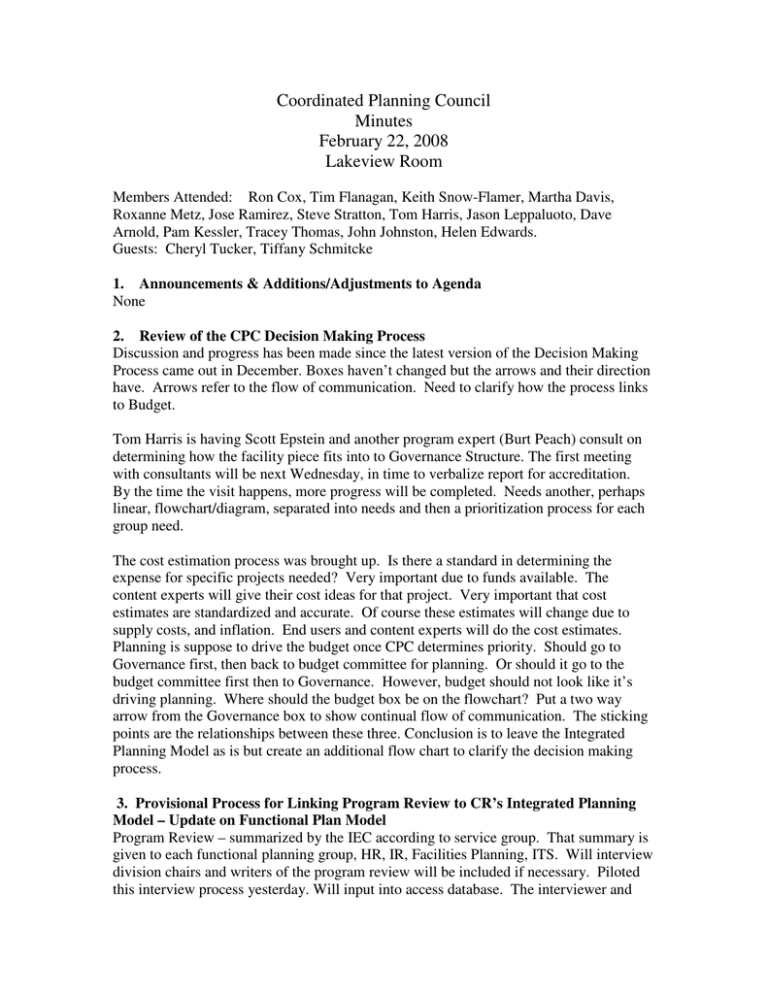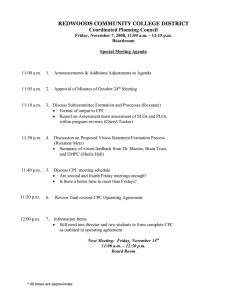Coordinated Planning Council Minutes February 22, 2008 Lakeview Room
advertisement

Coordinated Planning Council Minutes February 22, 2008 Lakeview Room Members Attended: Ron Cox, Tim Flanagan, Keith Snow-Flamer, Martha Davis, Roxanne Metz, Jose Ramirez, Steve Stratton, Tom Harris, Jason Leppaluoto, Dave Arnold, Pam Kessler, Tracey Thomas, John Johnston, Helen Edwards. Guests: Cheryl Tucker, Tiffany Schmitcke 1. Announcements & Additions/Adjustments to Agenda None 2. Review of the CPC Decision Making Process Discussion and progress has been made since the latest version of the Decision Making Process came out in December. Boxes haven’t changed but the arrows and their direction have. Arrows refer to the flow of communication. Need to clarify how the process links to Budget. Tom Harris is having Scott Epstein and another program expert (Burt Peach) consult on determining how the facility piece fits into to Governance Structure. The first meeting with consultants will be next Wednesday, in time to verbalize report for accreditation. By the time the visit happens, more progress will be completed. Needs another, perhaps linear, flowchart/diagram, separated into needs and then a prioritization process for each group need. The cost estimation process was brought up. Is there a standard in determining the expense for specific projects needed? Very important due to funds available. The content experts will give their cost ideas for that project. Very important that cost estimates are standardized and accurate. Of course these estimates will change due to supply costs, and inflation. End users and content experts will do the cost estimates. Planning is suppose to drive the budget once CPC determines priority. Should go to Governance first, then back to budget committee for planning. Or should it go to the budget committee first then to Governance. However, budget should not look like it’s driving planning. Where should the budget box be on the flowchart? Put a two way arrow from the Governance box to show continual flow of communication. The sticking points are the relationships between these three. Conclusion is to leave the Integrated Planning Model as is but create an additional flow chart to clarify the decision making process. 3. Provisional Process for Linking Program Review to CR’s Integrated Planning Model – Update on Functional Plan Model Program Review – summarized by the IEC according to service group. That summary is given to each functional planning group, HR, IR, Facilities Planning, ITS. Will interview division chairs and writers of the program review will be included if necessary. Piloted this interview process yesterday. Will input into access database. The interviewer and interviewee will sit together and fill in the data elements. This will then produce a report that will be accessible online to all. Need to close the link between program review and the budget. This will be a changing process as needs change. It’s recognized that we don’t know what a particular program costs. During the interview and database entering phase, by using activity codes we can identify for information reasons and to capture data that will link to budgetary impacts, the necessary expenditures involved. The Functional Planning Groups will report into db what their needs are. Action plan items will be identified and coded. Prioritization will have to be determined. The need (safety, action plan, etc.) will determine where it links to the budget. Long discussion ensued pertaining to the arrow direction flow and box location of Budget, the Strategic Planning and Governance. Between the IEC and the CPC, a decision will be made regarding the budgetary impact. The direct link to the budget occurs in the final prioritization of the projects. TH: when the CPC sets dollar amount available that is the budget link. After CPC determines priority – then what? 4. Action Planning a) Review of Action Plan Guidelines Criteria for judging action plans – - how does the action plan meet the mission/goals of the college? - Alignment of goals and objectives - Reasonable, attainable, sustainable - Measurable objectives - Accreditation standards Discussion about how to rate/score/grade the plans. KSF, RM & JJ will come up with a timeline, a process, what to expect on the 14th and a Rubric. Will use a Likert scale of 17, will judge individually and then aggregate results. The costs as determined by each action plan is critical. How can this be standardized? Routine maintenance of enacted action plans, hidden costs, salary support? After implementation of Action Plan, the plan must be evaluated by the initiator. These progress reports are required. What if the project fails – associated costs with failure. If ongoing costs are institutionalized, how does that cost center request more funding for those ongoing costs? It was discussed and decided to open up the eligibility to all part time employees. What is the managers role in signing off the Action Plan? Budgetary? Add comments if necessary to clarify your role and thoughts on the plan. b) Review of CPC Process and Timeline Need to be ready for the 14th & 28th, Fridays 9-1130am the CPC meets to review the proposed Action Plans. On the 14th – will be the first read of all plans. On the 28th – will be the decision making day. Need to discuss how this review process will look. Be prepared to read, invite the proposers to CPC to clarify any questions on their plans. Proposals are due the 7th, might push to the 5th due to meetings. 5. Baseline Data on Key Performance Indicators Website needs a lot of work. In ARCC report we are below our peer colleges. The college only has control over a certain percentage of persistence. Locally there is a limited job market, transient population. - Persistence rate is decreasing - completions have also decreased over time - certificates have increased Data on certificates/graduation not as meaningful as it “should” be. Students not ‘enrolled’ in programs. Discussed survey results and potential future surveys. Submitted by: Tiffany Schmitke

